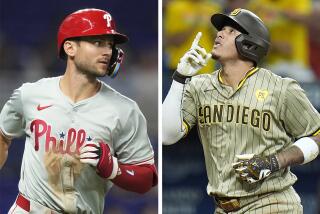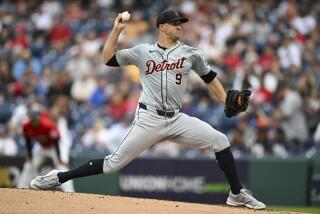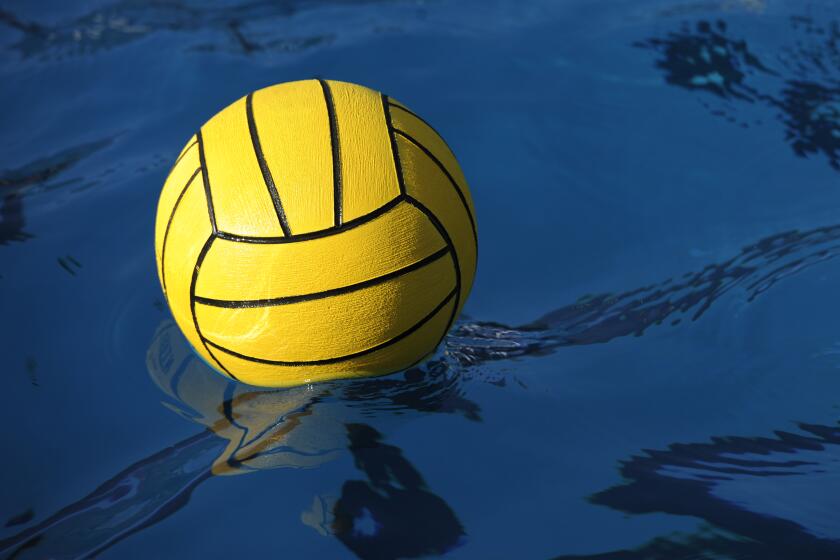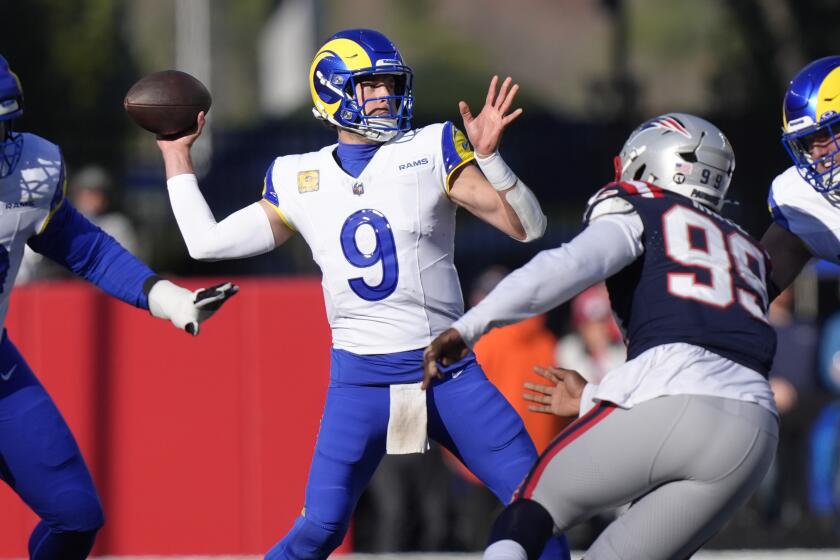For Dodgers and Angels, some July trades have worked and some, well ...
The Dodgers are chasing a starting pitcher, or two. The Angels covet a left fielder. Both teams would like to add a relief pitcher.
The trade season has gotten underway without them. On Sunday, the Kansas City Royals got pitcher Johnny Cueto, three days after the Houston Astros got pitcher Scott Kazmir.
While the fans of Los Angeles wait to see whether the Dodgers trade for Cole Hamels or David Price — a third ace to accompany Clayton Kershaw and Zack Greinke — we decided to look back at several notable July deals for the Dodgers and Angels.
Keep in mind that the trade season does not end when July does. Trades still can be made in August, although players must first clear waivers, and in September, although players acquired then are not eligible for postseason play.
Dodgers trades: Three July victories
July 31, 2008: Dodgers acquire outfielder Manny Ramirez from the Boston Red Sox for infielder Andy LaRoche and pitcher Bryan Morris.
This might have been the greatest giveaway in baseball history. Under owner Frank McCourt, the Dodgers weren’t taking on any money. The Red Sox were sick and tired of Ramirez, so they offered him for free — we’ll pay all of his salary, please just take him. The Dodgers said yes, and they were rewarded with a historic display of hitting — .396 in two months, with 17 home runs and 53 runs batted in over 53 games — and a stadium transformed into Mannywood. Dodger Stadium had not seen such rapture since Fernandomania. Ramirez led the Dodgers to the National League Championship Series, their first trip there since 1988, and hit .520 in the playoffs. Never mind the postscript — the sparring over a new contract, the suspension for violating baseball’s drug policy, the sour attitude — no deadline trade paid dividends like this one.
July 24, 2012: Dodgers acquire shortstop Hanley Ramirez and pitcher Randy Choate from the Miami Marlins for pitchers Nate Eovaldi and Scott MacGough.
Eovaldi would look mighty nice in the Dodgers rotation right now, but this trade nonetheless rates as a huge victory. Just as they did with Manny Ramirez, the Dodgers got an elite hitter with a questionable disposition. But this was different too. The Dodgers took on all of the $36 million owed to Hanley Ramirez, evidence to the baseball world that the McCourt era was buried and the Guggenheim cash was flowing, and they got the considerable competitive advantage of playing an excellent hitter at a premium defensive position. Hanley Ramirez did not play the position well, but he finished eighth in NL most-valuable-player voting in 2013 and hit .500 in a division series. A fastball to his rib cage all but ended the Dodgers’ hopes in the league championship series, and his time in L.A. ended badly, as it did for Manny Ramirez, but a great trade nonetheless.
July 31, 2004: Dodgers acquire outfielder Steve Finley and catcher Brent Mayne from the Arizona Diamondbacks for outfielder Reggie Abercrombie, catcher Koyie Hill and pitcher Bill Murphy.
Finley’s Dodgers career was defined by one grand moment: a walk-off slam he hit on the next-to-last day of the season to clinch the Dodgers’ first playoff berth in eight years. Frank and Jamie McCourt, then married, danced on the field after the game. But this trade is most memorable for what the Dodgers did not do: after the 39-year-old Finley hit 13 home runs in 58 games for the Dodgers, they did not re-sign him despite his productivity and September glory. The Angels signed him for two years and $13 million, and he was gone after one year. He was 40. Who knew?
Dodgers trades: Three July losses
July 4, 1998: Dodgers acquire pitcher Jeff Shaw from the Cincinnati Reds for infielder Paul Konerko and pitcher Dennys Reyes.
That the Dodgers surrendered a top prospect in Konerko for a closer in Shaw when they were eight games out of a playoff spot was curious enough. But Tom Lasorda, in his second week as interim general manager, also was unaware that Shaw had the right to demand a trade at the end of the season. Shaw used his leverage to get a new contract from the Dodgers, but they never made the playoffs with him. Eric Karros had blocked Konerko at first base in L.A., but Karros’ decline started in 2000, and Konerko went on to hit 439 home runs, nearly all with the Chicago White Sox. This trade looks worse today than on the day the Dodgers made it.
July 30, 2004: Dodgers acquire pitchers Brad Penny and Bill Murphy, and first baseman Hee-Seop Choi from the Florida Marlins for catcher Paul Lo Duca, pitcher Guillermo Mota and outfielder Juan Encarnacion.
To this day, Jim Tracy laments this trade, when rookie General Manager Paul DePodesta tore out the heart and soul of the manager’s clubhouse, and of a first-place team. Tracy felt he had to overwork closer Eric Gagne to overcome the loss of trusted setup man Mota, although in retrospect DePodesta sold high on a guy who pitched the eighth inning. Lo Duca was enormously popular, and he was an All-Star in 2003, 2004, 2005 and 2006. The trade flopped for two reasons: Choi was so poor on defense that Tracy shuddered to play him, and the big hole in his swing outweighed the home runs and walks (statistical analysts rip Tracy for not playing him, but Choi never got another major league job). More importantly, Penny got injured. The Dodgers got him to be their ace, but when they made the playoffs in 2004, for the first time in nine years, their starters were Odalis Perez, Jeff Weaver and Jose Lima. Penny pitched 397 innings over the next two years, and started the 2006 All-Star game for the NL, but he was so ineffective late in the 2006 season that he did not start in the playoffs that year, either.
July 26, 2008: Dodgers acquire third baseman Casey Blake from the Cleveland Indians for catcher Carlos Santana and pitcher Jon Meloan.
The Dodgers were a game under .500 but also a game out of first place, so they wanted to win. But they had no money, so Frank McCourt decreed that any trades could not increase the payroll. When the Dodgers had the framework of a CC Sabathia deal in place, McCourt said no. So the Dodgers went back to the Indians and got Blake, a perfectly fine third baseman. The grievance here is not so much that the Dodgers traded Santana, who blossomed into an excellent hitter in Cleveland. It is that the Dodgers had to trade a top prospect so the Indians would agree to cover Blake’s salary. Think about it: the Dodgers would not pay up for Sabathia, but the Milwaukee Brewers would. Dark days indeed.
Angels trades: Three July victories
July 29, 2008: Angels acquire first baseman Mark Teixeira from the Atlanta Braves for first baseman Casey Kotchman and pitcher Steven Marek.
This was the first summer after the eight-year reign of Bill Stoneman, who made his big deals in the off-season. The Angels delighted their fans by landing Teixeira, who batted .358 with 13 home runs in 54 games. They did it relatively cheaply, too. Marek was a middle relief prospect. Kotchman was their 25-year-old starting first baseman, but the Angels had Kendrys Morales on deck if they could not re-sign Teixeira. They did not, although the process did put relations between Angels owner Arte Moreno and agent Scott Boras into the big chill, and the New York Yankees signed Teixeira for $180 million. Three years later, Moreno signed another first baseman: Albert Pujols for $240 million.
July 19, 2014: Angels acquire pitchers Huston Street and Trevor Gott from the San Diego Padres for pitchers R.J. Alvarez, and Elliot Morris, and infielders Taylor Lindsey and Jose Rondon.
Jerry Dipoto resigned this month as the Angels’ general manager, but this trade might stand as his masterpiece. Street has remained one of baseball’s best closers — a 2.00 earned-run average for the Angels and 42 of 45 save opportunities converted — and Dipoto signed him to a reasonable two-year, $18-million extension through 2017. Gott, acquired as a double-A reliever, emerged one year later in Anaheim as a trusted late-inning arm. The key prospect sent to the Padres, Rondon, is a 21-year-old shortstop batting .190 with a .449 OPS at double A.
July 29, 1997: Angels acquire pitcher Ken Hill from the Texas Rangers for catcher Jim Leyritz and infielder Robert Sasser.
The Angels did incredibly well in this trade — in the season they made it, that is. Hill gave the upstart Angels a boost in the starting rotation. He had a 3.65 ERA in Anaheim that year, the ERA of the other six pitchers to start most often ranged from 4.23 to 6.00. The trade also cleared the catching spot for power-hitting prospect Todd Greene, who hit nine home runs in 34 games. But Hill signed for another three years and $16 million, and his performance fell so far the Angels dumped him before his contract expired. Greene, plagued by injuries, never fulfilled his considerable potential.
Angels trades: Three July losses
July 31, 1996: Angels acquire pitcher Greg Gohr from the Detroit Tigers for infielder Damion Easley.
After five years of waiting for the touted Easley to deliver performance worthy of the hype, the Angels dumped him on the Tigers in the classic change-of-scenery trade. Gohr, a first-round pick drafted just ahead of Tom Goodwin and Mo Vaughn, won one game for the Angels in 1996 and never again pitched in the major leagues. Easley? He hit 22 home runs for the Tigers in 1997, 27 in 1998, 20 in 1999 while the Angels were running through Randy Velarde, Luis Alicea, Norberto Martin, Justin Baughman, Jeff Huson and Trent Durrington at second base. Easley retired in 2008, a dozen years after Gohr.
July 27, 2012: Angels acquire pitcher Zack Greinke from the Brewers for infielder Jean Segura, and pitchers Johnny Hellweg and Ariel Pena.
This trade would be judged a success under one of two conditions: the Angels made the playoffs in 2012 or they signed Greinke that off-season. Neither happened. The Angels finished five games out of first place in 2012 and then lavished their off-season bounty on outfielder Josh Hamilton rather than Greinke. The Angels had some concerns about Greinke’s elbow, and maybe they never could have outbid the Dodgers during the first off-season of Guggenheim ownership, but the Angels’ pitching help that off-season consisted of Joe Blanton, Sean Burnett, Ryan Madson and Tommy Hanson. With Hamilton, that’s 0 for 5. Segura, whom the Angels weren’t sure could play shortstop, made the NL All-Star team at shortstop in 2013.
July 27, 1995: Angels acquire pitchers Jim Abbott and Tim Fortugno from the White Sox for pitchers Andrew Lorraine, Bill Simas and John Snyder, and outfielder McKay Christensen.
At the time, this trade looked as if the Angels were bolstering their starting rotation for the playoffs. They brought back Abbott, even producing souvenir buttons to commemorate their reunion with the fan favorite, to join Chuck Finley and Mark Langston atop the rotation. The Angels had an eight-game lead on the day of the trade, a lead that expanded to 11 games two weeks later, before staging one of the greatest collapses in baseball history. Abbott pitched well as the team fell apart around him, but then the Angels re-signed him for three years and $7.8 million, and he fell apart the next year. He was 2-18 in 1996 and sat out 1997, a painful experience for a popular and unusually accountable athlete.
MORE BASEBALL NEWS:
Mike Trout’s grand slam leads Angels in 13-7 win over the Rangers
Zack Greinke’s scoreless streak ends at 45 2/3 innings; Dodgers lose
Baseball Hall of Fame welcomes Johnson, Martinez, Smoltz, Biggio
More to Read
Go beyond the scoreboard
Get the latest on L.A.'s teams in the daily Sports Report newsletter.
You may occasionally receive promotional content from the Los Angeles Times.











